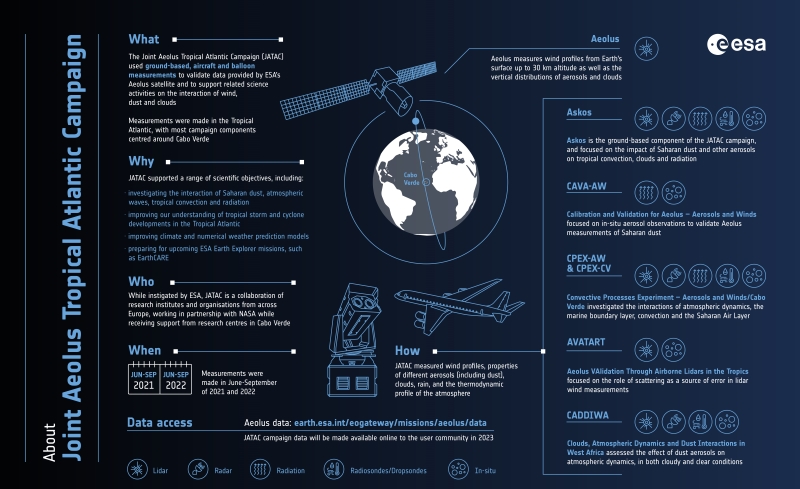- Learn & Discover
- Collaboration and perseverance...
Collaboration and perseverance key to success of JATAC
12 May 2023
A worldwide community of remote sensing experts came together at EGU 2023 in April to discuss the achievements of an atmosphere dynamics and composition field campaign completed over the tropical Atlantic.
The Joint Aeolus Tropical Atlantic Campaign (JATAC) – which took place in Cabo Verde and the US Virgin Islands in 2021 and 2022 – uses measurements from ground-based and airborne sensors to validate data from ESA’s Aeolus satellite, prepare for future atmosphere-studying missions, and study interactions between wind, dust and clouds.

The campaign focused on the tropical part of the Atlantic because Aeolus wind profiles have been demonstrated to greatly improve weather forecasts in this region.
Winds are known to influence weather patterns in the tropics by blowing Saharan dust over the ocean, impacting the development of convection and the formation of tropical storms – and JATAC is improving understanding of these tropical atmospheric processes.
The campaign is split into several elements that focus on specific areas of study and each of these components builds on monitoring campaigns coordinated by research organisations from around the world.
It takes a village
Thorsten Fehr, Head of ESA’s Atmospheric Section, introduced the session by commenting, “JATAC was not without its challenges – including those imposed by the coronavirus pandemic – but thanks to the cooperation and perseverance of the hundreds of scientists, engineers and pilots in the JATAC community, the campaign delivered impressive findings, achieving and surpassing its initial objectives.”
The campaign is a testament to what can be achieved through pooling expertise and experience from many fields of atmospheric science, Fehr added.
A diverse range of observation techniques were implemented as part of JATAC, such as crewed remote sensing aircraft, atmosphere-monitoring drones, and advanced ground-based instrumentation.
Presentations detailed how these efforts provided valuable information to help scientists understand how Aeolus observations perform under the atmospheric conditions of the tropical Atlantic, enabling the validation, calibration and optimisation of the mission’s data products, including the Aeolus Level-2A Aerosol/Cloud optical product.
From the Sahara to the tropics
During the session, updates were delivered on the different components of JATAC, including the first scientific highlights of the Clouds-Atmospheric Dynamics-Dust Interactions in West Africa (CADDIWA) project.
CADDIWA teams used a range of in-situ, airborne and spaceborne sensors to track the 3D distribution of Saharan dust and identify pathways though which dust is blown over the ocean. This information was combined with data on the occurrence of large-scale tropical thunderstorms, to better understand how dust influences tropical storm formation and intensity.
In addition, an unprecedented dataset for the study of dessert dust was presented by the teams working on the ASKOS component of JATAC. The dataset is based on ground-based observations and atmospheric measurements which were gathered using the facilities of the Ocean Science Center Mindelo on Cape Verde.
As well as the intensive campaign periods in summer 2021 and 2022, ASKOS has established a long-term record covering the time between the campaigns through its ACTRIS component.
ASKOS was complemented by the “Calibration and Validation for Aeolus – Aerosols and Winds” project (CAVA-AW), which provided in-situ airborne dust observations in the area of the Cape Verdean islands.
Impressive results
Also highlighted in the session was the significant contribution of JATAC’s AVATAR-T team to the validation of Aeolus wind products.
Building on three earlier campaigns in Central Europe and Iceland, observations from the ALADIN Airborne Demonstrator and doppler wind lidars onboard a DLR Falcon-20 aircraft provided precise quality assessments of wind profiles gathered by Aeolus.
Findings were also presented from the Convective Processes Experiment, which is made up of two studies named CPEX-CV and CPEX-AW that focused on the western and eastern tropical Atlantic in 2022 and 2021, respectively.
These experiments employed NASA’s DC-8 remote sensing aircraft, which was dispatched over Cabo Verde for CPEX-CV and over the US Virgin Islands for CPEX-AW to investigate a range of processes related to storm formation.
To closely coordinate the measurements collected during JATAC, dozens of research institutes from across Europe and the US worked in partnership with ESA and NASA, supported by scientists and institutions on the ground at Cabo Verde.
Tommaso Parrinello, ESA’s Mission Manager for Aeolus, concluded by saying, “In order to deliver high-quality data to the community it is vital to implement a consolidated calibration and validation strategy.
“The findings presented here demonstrate how crucial JATAC is to these activities and the campaign would not have been possible without the collaboration, determination and expertise of our community of scientists and engineers from organisations across the world.”